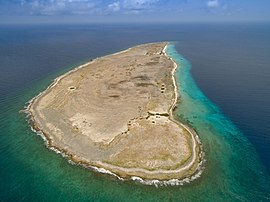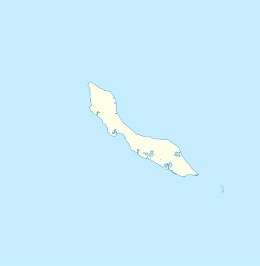Klein Curaçao
 Aerial view of Klein Curaçao | |
| Geography | |
|---|---|
| Coordinates | 11°59′34″N 68°39′03″W / 11.99278°N 68.65083°W |
| Area | 1.7 km2 (0.66 sq mi) |
| Administration | |
| Country | Curaçao |
| Demographics | |
| Population | 0 ( 2000 ) |
| Official name | Klein Curaçao |
| Designated | 31 July 2018 |
| Reference no. | 2355[1] |
| Klein Curaçao Lighthouse | |
 The lighthouse at Klein Curaçao stands 22 meters tall and is lit by a solar-powered LED light | |
| Constructed | 1850 (first) 1879 (rebuilt) |
| Construction | masonry tower |
| Height | 20 m (66 ft) |
| Shape | cylindrical tower with balcony and lantern[2][3][4] |
| Markings | white tower, red lantern |
| Power source | solar power |
| First lit | 1913 (rebuilt) |
| Focal height | 25 m (82 ft) |
| Range | 15 nmi (28 km; 17 mi) |
| Characteristic | Fl(2) W 15s |
Klein Curaçao (English: Little Curaçao) is a 1.7-square-kilometre (170 ha; 0.66 sq mi) uninhabited island belonging to, and lying 10 km south-east of, Curaçao, a constituent country of the Kingdom of the Netherlands in the Dutch Caribbean.
Description
[edit]Klein Curaçao has a desert climate (in the Köppen climate classification BWh and BWk), a climate in which there is an excess of evaporation over precipitation. The only structures on the island are an old lighthouse, a beach house, and several huts. Klein Curaçao is well known as a beautiful diving spot because of its coral and underwater caves. The island has no permanent inhabitants, only a few palm-frond-covered sheds for day trippers from Curaçao, and apart from some coconut palms has little vegetation. There are some fishermen's huts where fishermen normally stay for some days. They get water from the Coast Guard of Curaçao. The windward side is a graveyard for boats that did not stay out far enough or lost power. A small tanker, the Maria Bianca Guidesman, is gradually being demolished by the constant pounding of the waves since 1988.[5] The remains of four or five boats have been washed far onshore. As with Curaçao, hurricanes are few, but several storms have left their mark; the 1877 hurricane destroyed the first lighthouse. The next lighthouse, which still survives, was built in the interior of the island.
History
[edit]The island played a part in the slave trade. The Dutch West India Company brought many slaves from Africa to Curaçao. Before these slaves came ashore in Curaçao, the sick were placed in quarantine at Klein Curaçao. The remains of this first quarantine building can still be found in the northwest of the island. The slaves, and other passengers who did not survive the voyage, were buried at Klein Curaçao. There are several graves in the southern part of the island. The Dutch West India Company were also given licenses to hunt the now extinct Caribbean monk seals on Klein Curaçao. In 1871, John Godden, an English mining engineer, visited the island, discovering there was a significant vein of phosphate on the island. From 1871 onward until 1886, the Dutch government set up mining operations on the island, with phosphate being mined and exported to Europe.
Environment
[edit]Once the phosphate was mined out, the level of the island dropped, and seabird populations plummeted. Goats were once allowed to roam the island, which contributed to its desertification. The goats were eradicated in 1996, as were feral cats by 2004.[6] Reforestation is being undertaken by CARMABI Marine Research Station, Curaçao. The island was designated as a protected Ramsar site in 2018.[1] It has also been identified as an Important Bird Area by BirdLife International as a nesting site for least terns, while its shores are used seasonally by large numbers of migratory waders. With the elimination of the goats and cats, the island has the potential to become an important seabird nesting location. Hawksbill, loggerhead and green sea turtles nest on the island's beaches.[6]
Gallery
[edit]-
Location of Klein Curaçao
-
Klein Curaçao lighthouse
-
Maria Bianca Guidesman aerial view
-
Klein Curaçao beach
-
Klein Curaçao
-
Klein Curaçao lighthouse
-
Maria Bianca Guidesman Shipwreck
-
Beach at Klein Curaçao
See also
[edit]References
[edit]- ^ a b "Klein Curaçao". Ramsar Sites Information Service. Retrieved 6 September 2018.
- ^ michaeljohngrist.com
- ^ Rowlett, Russ. "Lighthouses of Curaçao". The Lighthouse Directory. University of North Carolina at Chapel Hill. Retrieved 2016-09-06.
- ^ List of Lights, Buoys and Fog Signals Atlantic Coast. Retrieved 6 September 2016
- ^ Bianca Marie (Fundación Histarmar − Historia y Arqueología Marítima, Retrieved 11 May 2020.)
- ^ a b "Klein Curaçao, Curaçao". BirdLife Data Zone. BirdLife International. 2007. Retrieved 19 October 2020.









